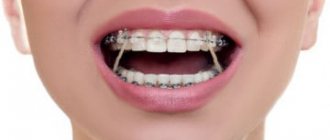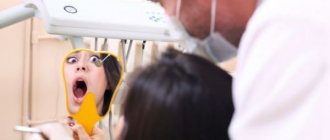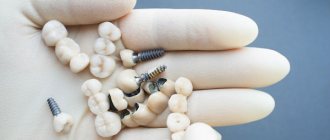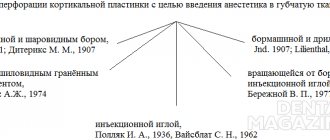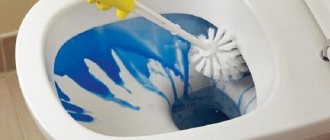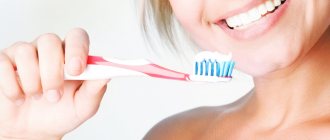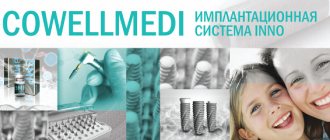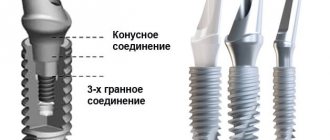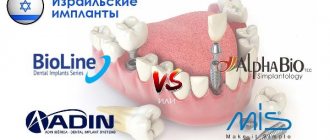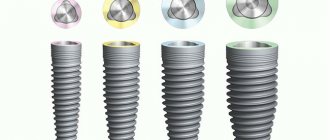German XiVE dental implants: design features, model range, pros and cons
XiVE dental implants are a relatively popular German brand that only appeared on the market in 2000. However, it belongs to the large Dentsply Implants holding, which has specialized in the development and production of implant systems since the 60s of the last century. The company also produces dental implants from such well-known brands as Ankylos and Astra Tech. Despite the short history of the XiVE brand, the manufacturer has impressive experience and a good scientific and clinical base, which allows it to produce high-quality and reliable designs applicable in a wide variety of clinical cases. Today we’ll talk in more detail about the systems of this German brand, consider the popular models of the brand and the features of their use.
A few words about the manufacturer
The large holding company Dentsply Implants launched active production activities back in the 60s of the last century. The company was at the forefront of the development of detailed implantology and today is one of the undisputed leaders in its segment.
As mentioned above, the manufacturer is engaged in the development and production of dental implants of such famous brands as Ankylos and Astra Tech, and in 2000 it also introduced the world to a new brand of modern high-quality implant systems - XiVE. Product production is concentrated in Germany and meets all international quality and safety standards. The company is actively developing and implementing new technologies to improve the quality characteristics of manufactured implants.
Immediate implantation and immediate prosthetics
The fact that Xive is young is undoubtedly a plus. First of all, because its design, construction and layout take into account all modern trends and realities. Let's take immediate implantation as an example. We held it for the first time in 2009:
and, to be honest, we very, very doubted our success. Now immediate implantation makes up approximately two-thirds of our implantology practice, and immediate prosthetics makes up almost 30%. This is largely due to the Xive implant system, and here's why.
Unlike the same Astra Tech, the Xive design was specially developed with immediate implantation in mind. Let's be honest, immediate implantation in many systems is far-fetched; they are simply not designed for this. And Xive is intended. Therefore, we can achieve acceptable primary stability even in the most difficult conditions:
Xive also comes with a TempBase abutment, which can be used to immediately make a crown. Or use TempBase Cap and make an easily removable temporary restoration. Yes, for convenience.
In many other implantation systems, even in the coolest Nobel Biocare, components for temporary prosthetics need to be purchased.
And if we want to preserve the gingival contour in an aesthetically significant area, we use customizable Teflon Esthetic Cap abutments. As I wrote in one of the previous publications, their use significantly reduces the need for mucogingivoplasty.
That is, we not only save money, but also reduce the trauma of the surgical operation, increasing its safety. We rarely resort to gum plastic surgery for immediate implantation. Very rarely:
Distinctive characteristics of XiVE implants
Dental implants produced under the XiVE brand have their own characteristics and unique characteristics. Among the distinctive properties of the presented structures, experts in the field of implantology highlight the following points.
Material: pure titanium
To create the structures, pure titanium is used - this is a high-strength and completely biocompatible material that does not cause allergic reactions and significantly reduces the risk of rejection of artificial roots. The material is reliable and completely non-toxic.
Special carving design
The special design of the coronal, that is, intraosseous part of the implant reduces the degree of injury to bone structures and promotes compaction of hard tissues, that is, creates a compression effect. Friadent models have a combination thread. At the end of the product it is quite deep, which simplifies the process of implanting the structure. Towards the middle of the implant body, the depth of the turns decreases, thereby ensuring maximum strength of the artificial root attachment and high levels of its primary stability. This feature makes it possible to achieve reliable fixation of the product even in fairly soft bone and in the presence of bone defects.
Surface with micropores
The implants have a unique patented FRIADENT plus coating, which ensures accelerated osseointegration by increasing the area of adhesion of the structure body to living bone tissue. The titanium rod is subjected to special processing using a special abrasive and acids. As a result, the product receives a microporous structure, which promotes faster and more effective engraftment, and also reduces the likelihood of complications, including peri-implantitis.
Hex connection for sealed abutment fixation
The presence of a reliable hexagonal connection with the abutment ensures complete vacuum during fixation and eliminates the appearance of gaps between the implant and its fastening component. Moreover, the latter can be installed in one of six possible positions, and its hexagonal shape prevents the element from scrolling. It is also possible to switch platforms to solve complex clinical problems.
XiVE implants have a number of individual features
What are the indications and contraindications for installing implants?
Systems of the German brand are used in various clinical situations, including for solving quite complex problems. These implants have proven themselves well within the framework of such technologies as classical two-stage implantation, one-stage immediate loading protocols, one-stage implantation of a rod immediately after tooth extraction, minimally invasive installation - through a puncture, and not by cutting the gums.
Artificial roots are used in the following clinical cases:
- single and multiple restorations,
- complete prosthetics on implants with subsequent installation of removable and non-removable orthopedic structures,
- restoration of the smile area and end defects,
- in conditions of a narrow alveolar ridge, insufficient height and bone density,
- with not too pronounced symptoms of inflammation of periodontal tissues,
- for solving complex clinical problems when implants of other brands cannot be used.
Implantation will help solve the problem of missing teeth.
Absolute contraindications in this case will be the same as for the use of implants from any other manufacturer: acute infectious diseases and chronic ones in the acute stage, serious chronic pathologies such as diseases of the cardiovascular system, uncompensated stage of diabetes, oncology and mental disorders. Implantation is also not performed in the presence of such relative contraindications as pregnancy and breastfeeding in women, the presence of heavy plaque and dental deposits, untreated carious cavities and inflamed areas of the mucous membrane. Only after the condition of the oral cavity is completely in order can you begin to restore missing teeth with the help of implants.
Installation of XiVE implants immediately after tooth extraction
It is important to understand that immediately after tooth extraction, a slow but irreversible process of atrophy of the jaw bone tissue in the area of the healing socket begins. This happens for the simple reason that the bone here ceases to receive sufficient chewing load.
It is also useful to read: Israeli dental implants MIS
This process occurs most dynamically in the first 2-3 months after tooth extraction, and after 3 years you can lose up to 60% of the original volume of bone tissue. Well, since there is no bone tissue, then there will be nothing to install the implant into. In such cases, if you still want to install an implant, you will need to first increase the bone volume by performing osteoplasty (or mucoplasty).
And here a completely reasonable question arises: why carry out additional operations when bone tissue can be used in its original volume by installing an implant in the socket of a just extracted tooth?
Moreover, this would save a lot of time compared to classic two-stage implantation, when first you would have to wait for the hole to heal.
It is not surprising that the so-called immediate implantation technique (when an implant is installed in the jaw immediately after tooth extraction) is becoming increasingly popular today. And XiVE implants, according to a number of practicing implantologists, are more suitable for this technique than many other brands.
On a note
Today, there are implant models with aggressive threading, which allows for high primary stability, but involves unnecessary trauma to the bone. The second type is implants with a small thread pitch and shallow depth; they injure bone tissue less, but often when using them, implantation with immediate loading is impossible due to the low primary stability of the implant.
According to a number of experts, a “golden mean” was found in XiVE implants, that is, low trauma to tissues is achieved by reducing the pitch and size of the thread, but at the same time, the macro design of the implants makes it possible to achieve high primary stability in the jaw - you can proceed to prosthetics and immediately load the implant.
In general, the XiVE system, if used for immediate implantation, has the following advantages:
- relatively little trauma to bone tissue;
- high primary stability of the implant in the jaw;
- low probability of the implant jamming when screwing it into the bone (for certain types of thread this also happens);
- and, finally, the possibility of instant loading with the prosthesis.
For the patient, all this means a quick and painless recovery after treatment and, importantly, getting a beautiful smile (or the ability to chew) on the same day that the diseased tooth was removed.
Review:
“...I still trusted my doctor and chose German implants. We installed Xive, two pieces, they’ve been on for 8 months now, I feel great. I was especially pleased that they were installed together with the removal of teeth. This is a huge plus, because work does not allow me to stay even for a day with holes in my mouth. I myself, of course, saw that it was a prosthesis, but neither my colleagues nor my wife noticed the difference. Later, the temporary prosthesis was replaced with a permanent one - now this is beauty, even I find it difficult to notice the difference with my natural teeth.”
Igor, Moscow
Popular XiVE implant models and their characteristics
The XiVE model range is quite wide and varied. The manufacturer's assortment includes various modifications designed for use in a wide variety of clinical cases. Let's take a closer look at the most popular models.
S plus Friadent range for two-stage implantation
A popular Friadent model, which is actively used for single restorations, as well as for the installation of bridge structures. The implant is indicated primarily for restoration using the classical method, when an artificial root is first fixed, and only after its complete engraftment is a crown attached. The sizes of the products presented in the line vary from 11 to 18 mm in length, and diameter - from 3 to 5.5 mm.
The S plus Friadent line is designed for two-stage implantation
TG Friadent for one-stage implantation
This model is used mainly for one-stage implantation, when a temporary crown is fixed immediately after installing the rod. This technique is relevant for one-stage technology, in which the implant is implanted directly into the socket immediately after tooth extraction, or if not much time has passed since the extraction (usually up to 3 months). The model is intended for use in transgingival implantation - the gum is not cut, it is implanted into a titanium rod through a small puncture in the mucous and bone tissue. This allows you to reduce the trauma of the procedure, facilitate the rehabilitation period and reduce the risk of complications. The length of the structure varies from 8 to 18 mm.
TG Friadent models are used for one-stage implantation
Modification 3.0 Friadent
The name of the model speaks for itself - index 3.0 corresponds to the diameter of the product. The Friadent 3.0 implant is a subtle modification that is suitable for complex clinical problems, for example when there is insufficient bone tissue or the alveolar ridge is too narrow. The model is also used when there is not enough space to install the structure. It is mainly used for the restoration of front teeth that fall within the smile area.
Cercon model based on zirconium oxide
Products based on zirconium oxide are used in cases where the clinical situation places increased demands on the aesthetics of prosthetics. When combined with abutments made of the same material, the entire system gains increased strength and the ability to achieve better aesthetics when replacing anterior teeth.
AuroBase implants
The implant is created strictly individually for the patient and the anatomical parameters of his dental system. It is used to solve complex problems when standard implants and their components cannot provide the required degree of quality and reliability of the final result.
Types of implants
As you know, XiVE Friadent implants have the following varieties:
- Conventional implants, which are installed after treatment of infectious diseases, due to which bone tissue can atrophy (periodontal disease, gingivitis, periodontitis, and so on).
- Thin implants that are installed during single-stage implantation and in the event that the bone tissue is not depleted (as a result of physical trauma to the jaw).
To find out which implants are more suitable, you need to undergo a medical examination, during which the doctor, if necessary, will carry out treatment and additional procedures. It is also worth considering that if you install implants without treating diseases, then over time they will begin to turn black, collapse and “leave” the oral cavity.
What types of abutments does the manufacturer offer?
The company also offers a wide selection of abutments, which allows you to successfully solve various clinical problems. Here are just the main types of components that are used most often:
- CERCON is a high-quality high-tech abutment model made of zirconium alloy. It is characterized by strength and reliability, allowing you to achieve high levels of aesthetics in prosthetics. Indicated for use as part of the restoration of the smile area,
- TempBase – used to install a temporary crown immediately after implantation of an artificial root,
- AuraBase are individual abutments that are made to order and, according to the manufacturer, allow you to achieve high aesthetic results in atypical clinical cases,
- FRIADENT MP are universal abutments used to support bridges and screw-retained bar structures (on multiple implants). Suitable for both two-stage technology and one-stage treatment protocols.
The manufacturer offers a wide selection of abutments.
The choice of one or another type of abutment is at the discretion of the treating specialist. The doctor develops a treatment plan, selects models of implants and suprastructures for them, based on the individual characteristics of the clinical picture of each individual patient.
Features of prosthetics on XiVE implants
One of the compelling arguments in favor of XiVE implants is the wide range of possibilities for prosthetics. The manufacturer offers an impressive range of abutments, many of which are universal, that is, they can be installed on implants of various diameters. There are both temporary TempBase abutments for immediate prosthetics immediately after implant installation, and structures for fixing permanent orthopedic solutions. Standard titanium XiVE fasteners are well suited for restoring chewing molars, but for the restoration of the smile area, the manufacturer specially offers zirconium CERCON models - durable and at the same time aesthetically pleasing, do not show through the gums and do not spoil the appearance of the smile.
Along with the implantation systems, the manufacturer also supplies all the necessary instruments for the operation. The orthopedic set includes 0.9 and 1.22 mm hex screwdrivers, all versions of the controlled lock screwdriver for normal and ratchet use, screw tightening tools and ball attachments. It also offers detailed instructions on how to use the key and screwdrivers, in what order.
One platform for all times
Recently, Ivan Algazin and I had a patient who had implants installed in the early nineties...
They cannot be confused with anything - this is FRIALIT-2, the “father” of the Xive implantation system. The FRIALIT-2 platform, created already in 1992, turned out to be so successful that in the future it remained almost unchanged structurally, but increased precision, and then completely switched to Xive with the index S (subgingival).
Knowing all this, we easily updated the prosthetic structures on these implants:
We had no problems with ordering spare parts or with tools - FRIALIT-2 and Xive are fully compatible.
Thus, we have overcome a situation that would have been insurmountable for many other implantation systems.
What are the advantages and disadvantages?
XiVE systems have many obvious advantages, which sets them apart from similar products from other manufacturers in their segment. Among the main advantages, experts in the field of implantology highlight the following characteristics:
- a special porous hydrophilic surface improves the process of osseointegration, accelerates the engraftment of artificial roots in bone tissue, reduces the risk of complications and allows you to install a permanent crown 2-3 months after implantation,
- according to the results of clinical studies, the average survival rate of XiVE implants is 99.6%, and the rejection rate corresponds to 0.4%c1, while for many other manufacturers this figure varies on average within 3-4%,
- a special thread design helps improve primary stability and more durable fixation of the product in the thickness of bone tissue,
- the presence of an internal connection made in the shape of a hexagon eliminates the appearance of microgaps and the risk of inflammation due to food particles getting under the structure,
- patients note easy and quick rehabilitation after the implantation procedure,
- A wide selection of models and components for them allows you to select components to solve a wide variety of clinical problems of any complexity.
XiVE implants have wide possibilities for prosthetics
“My husband had two Xive implants installed. This happened several years ago, and artificial teeth still do their job perfectly. As far as I remember, everything went very easily for him; no complications arose after the operation. Now I have the same need, so I will get an implant of the same brand...”
IrishKa, Moscow, from correspondence on the woman.ru forum
The implants and suprastructures for them presented in the Friadent line cannot be called budgetary. But in this case, the price is completely justified, since the designs of this brand are truly distinguished by high survival rates, long service life, reliability and safety. Perhaps the only drawback of the brand is the inability to combine its products with elements of systems from other manufacturers.
Formation and preservation of the gingival contour
Having started a large study in 2020 on the influence of components for the formation of the gingival contour on the quality of this very formation, it was not in vain that I chose the Xive implant system. Because it has a sufficient variety of suprastructures intended for this stage of implantological treatment:
Many implant systems have the same type of gum formers, but in a huge range of sizes. There are few sizes in Xive, but the shapes themselves are very diverse. And that's right, I think.
What is the service life of XiVE structures?
The manufacturer provides a 10-year warranty on its products. But practice shows that with care and maintaining the health of the teeth and oral cavity, implanted structures can last much longer - more than a dozen years. In this matter, it is important to strictly follow all the instructions of the treating implant surgeon and systematically visit a specialist’s office for preventive examinations.
It should be noted that the warranty period for implantation of systems is a slightly different type of guarantee. It is installed by the clinic where the patient is being treated. Usually this period does not exceed 2 years. If the implant rejection occurred before the end of this period, the problem may have arisen due to incorrect actions of the doctor, violation of the technique of performing the procedure, or due to poor preparation for implantation. In such controversial situations, an examination is required.
Life time
The optimal service life of XiVE implant products is on average from 5 to 10 years. But if you believe numerous reviews from patients and implantologists, these products can last much more than 10 years, provided that all necessary care measures are followed. However, sometimes the structure can last only 3 years. Different service life can be influenced by various factors - regular oral hygiene, mechanical stress, individual characteristics, correctly performed surgery and other factors.
The average service life of XiVE implants is from 5 to 10 years, but if you believe numerous reviews, the products can last much longer.
How to properly care for your teeth after implantation and prosthetics
To eliminate the risk of rejection due to the patient’s fault, after the procedure the specialist gives detailed instructions on how to properly care for the oral cavity in the postoperative period. It is important to listen carefully to all the doctor’s instructions and then strictly follow his instructions - a responsible attitude towards rehabilitation will protect you from many unforeseen problems and complications.
Immediately after treatment, you will have to give up hard and sticky foods for a while, even if a crown or prosthesis was installed immediately. The intensity of chewing load should be increased gradually. You should also temporarily avoid visiting saunas and steam baths, hot baths, air travel, and activities that create a vacuum effect in the mouth, for example, you should not drink drinks through a straw or rinse your mouth vigorously. The doctor will prescribe the necessary medications, including painkillers and antibiotics, as well as antimicrobial solutions, which must be used with extreme caution, trying not to disturb the position of the implanted structure during rinsing.
Do not neglect the use of antibiotics
Important! Be prepared for the fact that in the first days after the procedure, swelling in the intervention area may persist, as well as minor pain - this is a natural consequence of tissue trauma during implantation. If the symptoms begin to intensify, severe swelling, bleeding, or even discharge of pus appears, you will need to see a doctor immediately.
In the future, after the implants have healed, it is important to maintain oral hygiene, regularly brush your teeth, rinse your mouth after every meal, use dental floss and, preferably, an irrigator. Also, do not forget to regularly visit the dentist for preventive maintenance - at least twice a year.
Read more about recommendations after implantation in our special article.
How Xive was tempered...
Xive is one of the youngest implant systems on the market, it appeared in 2001. For comparison, the history of Astra Tech began more than 30 years ago, and Nobel Biocare even earlier.
I see no point in retelling the history of modern implantology. If you wish, you can read about it here>>.
In short, it was like this: one hitherto unknown Swedish scientist, while experimenting with rabbits, suddenly noticed that if you carefully insert an object made of bioinert material into a bone, after a while it would be impossible to pull it out.
And so, instead of creating cybernetic organisms, superorganic robots and other seemingly fantastic crap, the Swedish scientist did not find anything better than to propose using the phenomenon of osseointegration that he discovered to support dentures.
It’s a no brainer that the capitalists liked the idea (there are a lot of toothless people), and after a while the market was flooded with thousands of different implant systems.
Among the pioneers of dental implantology was one Swiss doctor, Philippe D. Lederman, who thought:
“What will happen if you attach a denture to a newly installed implant?”
Assuming that primary stability would be the key success factor in this case, he came up with a completely new design of implants.
In 1977, he, collaborating with the little-known Swiss company Straumann AG, introduced the world to new self-tapping implants (see picture above). Pay attention to their macro design. Doesn't remind you of anything? Lederman’s implants or, as they were called then, “screws” were predecessors, among other things, of the Straumann implantation system. In addition, these implants were transgingival and had a very distinctive prosthetic interface that could be classified as an “external cone.” Previously, this type of platform was very common, but has now practically disappeared and is found only on basal implants.
In general, Dr. Lederman clearly showed in 1976 that prosthetic implants immediately after installation are, after all, kosher if certain conditions are met, first of all, the primary stability of the implants is achieved.
Another doctor, Willi Schulte, went even further. He thought:
“Why not place the implant directly into the socket of the extracted tooth?”
To do this, it was necessary to conjure up macro-design and slightly revise the surgical protocol - and in 1974, Friatec AG Ceramic & Plastic Company introduced Tubingen Implants to the market, a fundamentally new implantation system, the first of its kind specifically designed for immediate implantation.
In the same 1974, Tubingen Immediate Implants grew into a complete and conceptually new implantation system under the FRIALIT brand, and later, in 1999, a separate medical division, Friadent GmbH, was spun off from Friatec Co.
Subsequent experience with the use of ceramic implants showed their high efficiency, but revealed a number of serious problems. In particular, the choice of material was not the most successful, and the proposed macrodesign and concept did not have sufficient versatility, and therefore could not be used in a wide range of clinical cases. Many other implant manufacturers have faced the same problem, which has forced them to switch to titanium alloys, multi-component and multi-stage implantation systems.
Thus, in 1992, the ceramic FRIALIT was transformed into the titanium FRIALIT-2, produced in two modifications, FRIALIT-2 and FRIALIT-2 Screw:
The FRIALIT-2 implants received their own original platform, which is a sequence of bushings of different diameters (Tube-In-Tube) with an internal anti-rotation element, a hexagon. According to the developers, such a high-precision platform provided, in addition to significant joint strength, good tightness and was suitable for a wide range of superstructures.
And, by the way, it was in the FRIALIT-2 implantation system that color coding of platforms and suprastructures first appeared (1992), which later spread to other implantation systems and significantly improved ergonomics.
By the end of the nineties, dentistry made a qualitative leap forward - new materials and methods appeared, digital technologies took the first steps, and regenerative medicine was actively developing. It became clear to all manufacturers that existing implantation systems were rapidly becoming obsolete, and something had to be done about it.
And everyone acted differently. Some companies, like Astra Zeneca (developer of Astra Tech, Straumann AG, Sulzer Calcitek, etc.) decided that they were already screwed, slightly updated their product line and calmed down. The fact that we are working with very outdated Astra Tech Osseospeed implants, to which some innovations like TX and Profile are catching our ears, is a clear confirmation of this.
In justification, I can only say that the release of a new or radical update of an existing implantation system is a rather complicated thing and freaking expensive. Astra Zeneca has achieved excellent results with Osseospeed - why change anything if everything is already great? It’s easier to come up with some inconspicuous trick, like replace SLA with SLA+, serve it under a thick layer of marketing and corrupt science - and that’s it, people eat it up!
Friadent GmbH, a young company from Germany, thought differently.
To begin with, they gathered all the coolest European implant dentists in one room. Yes, yes, friends, all these icons and idols of yours, Marco Deguidi, Dr. Neugebauer, Fuad Khouri also ended up in this gang. In general, there were more than 10 people in the development group. They were given the task of creating the most awesome implantation system in the world, and they were given a condition: until you create it, we won’t feed you.
In other words, colleagues, all those whose courses you are currently attending, all those whom you now idolize and whose photos you regularly jerk off to - they all developed the Xive implantation system. It's a no brainer that they couldn't come up with this bullshit.
As I already told you earlier, the creation of an implantation system begins with the development of a platform - only then a macro design is attached to it, superstructures, a surgical protocol, etc. are added. Read about it here>>
So, the developers decided, after making minor modifications, to leave the Frialit-2 “Tube-In-Tube” platform, fortunately, it suited everyone. Thanks to modern technologies, they have increased the accuracy of its manufacture, but in general, the concept has remained the same.
Then a macro design was screwed to the platform (or rather, to two platforms), sharpened, among other things, for immediate implantation.
They immediately remembered Dr. Lederman with his immediate workload and decided that it would be nice to include the necessary components for it in the delivery set, and the tools - in a single general set.
Then they created the most simple and intuitive surgical protocol, a set of tools for which was developed and produced by the Swiss company Mailifer AG, little known to dentists.
And so, in 2001, the Xive implantation system entered the market . What happened next - you all know perfectly well:
Please note that unlike some companies with a red N logo that release new implants almost every year (which require new kits, tools, training...), Xive has not changed since 2003. Its further development is the emergence of new superstructures, improvement and optimization of surgical instruments, sets, etc. The implant itself remains the same.
Actually, friends, why am I telling you all this? Any implantation system, even the most moronic one, in your opinion, is the fruit of the labor of dozens of highly qualified engineers, doctors, scientists, researchers, and developers. This is an investment worth millions of dollars. These are years of testing, endless corrections and improvements. This is a long-term licensing, admission to production and clinical practice. These are nerves, money, blood, sweat, suffering, then nerves again - and so on in a circle.
The most important thing is that no new product appears out of nowhere - it is always the result of the evolution of knowledge, methods, skills and developments. Just as the car could not appear immediately, its creation was preceded by the invention of the wheel, the engine, the discovery of electricity, the achievements of chemistry, etc., so implants do not appear out of nowhere, they absorb all previous experience, knowledge, developments, concepts and theories.
Think about this before you trash implants you don't like. Maybe it's worth studying them better and learning how to work with them?
How much will installation cost?
XiVE brand implants are close to the premium segment, so their installation cannot be called budgetary. The estimated cost of a structure in Moscow varies from 30 to 40 thousand rubles, and much of the pricing depends on the level of prestige of the dental center. It should be noted that this is the cost of the implant itself and installation, but together with a crown, for example, made of metal ceramics, the restoration of one tooth will cost the patient approximately 70 thousand rubles. Today, dentures with zirconium crowns are widely popular - this is both a durable and aesthetic material. The cost of fixing a single zirconium prosthesis on a XiVE implant will cost approximately 85 thousand rubles.
- According to the information presented at the office. brand website: www.xive.ru
Cost of XiVE Friadent implants
The cost of implants also depends on their material and quality. In Moscow, the cost of XiVE Friadent implants is 20,000 rubles, and taking into account installation and additional procedures, the price will be 45,000 rubles. It is worth considering that implants are reliable and durable, so their high cost fully justifies their quality.
If you need high-quality and effective treatment for oral diseases, then you can contact our Diamantdent clinic, where you can restore the structure of your teeth and the beauty of your smile.
Zhalnin Dmitry Pavlovich
dentist-orthopedist
Sign up
